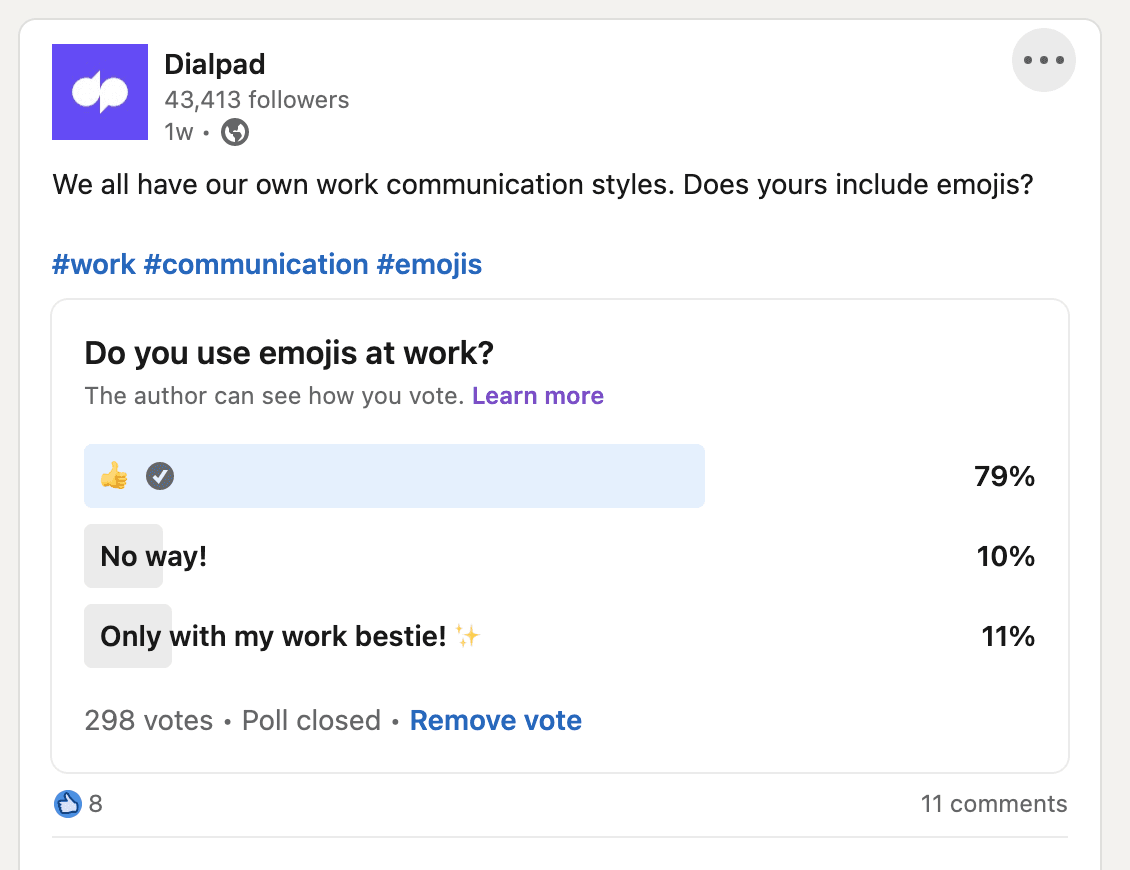Using Dialpad’s reactions, or: How I learned to stop worrying and love emoji

Content Writer

Tags
Share
Growing up with the emergence of internet chat, I’ve seen the evolution of emoji. I’ve seen them start as basic :) smileys (or more complex designs like <('.'<) if you were really feeling up for it) and grow into the artistic little designs they are today… including the era of text messages crammed full of emoji after emoji.
As such, I’ve always viewed them as informal, even unprofessional. The thought of using them in a business environment felt simply inconceivable.
And while I wasn’t the only one to feel that way, that way of thinking is on its way out. In fact, we here at Dialpad recently did a survey on LinkedIn, and out of nearly 300 respondents, 79% of them use emoji in their daily work communications. Another 11% use them infrequently (just with the coworkers they’re close with) leaving the emoji holdouts at just 10%.

(In fact, even my work computer has a built-in emoji keyboard, which I’ve been using a lot more than I ever expected.)
With so many employees using emoji in their daily work lives, let’s take a look at two ways Dialpad helps our customers use emoji, and what they can bring to a message or meeting.
Using emoji in chats
Emoji were first born as a way of expressing emotions through text, so it only makes sense that they’re an important part of Dialpad’s messenger. Dialpad includes a set of emoji that can be posted in chats or used as a reaction to other messages.
For remote and hybrid employees, these are helpful little tools for keeping communications clear in their messages. When we can’t meet face-to-face, emoji can take the place of body language and inflection to help get intent across.
For starters, emoji are great for indicating tone. There’s a big difference between messages reading “Do you have a moment?” And “Do you have a moment? 😀” (Mainly, only one of them gives me anxiety, and it’s not the one with the happy face.)

Need to acknowledge a message? You can leave a 👍 either as a reaction or send it as a response. Want to show support for a coworker when they post something important? 🔥, 🎉, and 👏 are all great ways to do it.
In fact, here at Dialpad, we often use emoji reactions when someone posts an announcement or praise for someone in our chats. It’s a good way for all those involved to see the recognition they’re getting, and it adds a little whimsy to chats.
Plus, using emoji reactions cuts down on notification spam in group chats. Imagine you needed to check in with a group to make sure everyone received and understands their instructions. You can either get notified five times as different people post “yep,” “got it,” and “okay” in the chat, or you can see that five people have left a 👍 reaction to indicate they’re all set. Only one of them will ping your notifications repeatedly.
In short: emoji reactions and comments are helpful tools for communicating intent and emotion, they can reduce message clutter, and they bring some visual flair to chats.

Emoji in video meetings
If Dialpad just used emoji in messages, that would be all well and good, but hardly worth writing about. But we don’t stop there—after all, Dialpad lets you send messages and have video meetings (and make phone calls, of course) from the same app, so why keep the emoji in just one place? That’s right: you can use emoji reactions during live video meetings.
How it works is simple: during a conference, you can click on the emoji menu on the bottom bar of the chat screen. Select an emoji and it’ll float by on the screen, visible but not obtrusive.
Have you ever been in a video conference, announcing some big news, when the screen erupts into 👏 emoji applauding you? It’s pretty magical. And at the same time, it doesn’t interrupt the flow of the meeting by having clapping come through a dozen different cameras.
Not only do emoji reactions in meetings provide a great way for participants to show their support in real-time and build camaraderie, they also keep everyone engaged by giving them something to contribute even if they’re on mute and have their cameras off.
Tl;dr: Emoji have a place in business
Despite my initial reservations about emoji, it turns out that they’re a great way to show engagement, participation, and voice. With so many people working remotely, using emoji in chats and meetings can convey tone even when we can’t be there to talk in person.
It’s little touches like this that show the thought and care Dialpad puts into everything, and all the useful little features included in everything. It would be one thing to just include an emoji keyboard, but emoji in meetings? That’s a step beyond.
So if you, like me, have been hesitant to use emoji before, now’s the time to make a habit out of it. Emoji are used for more than just overly-excited text messages these days.
… But if you have to message your boss some bad news, maybe don’t use the 📉🔥 emoji combo. (Trust me, it doesn’t help.)
Add some emoji to your team chats
Want to try out Dialpad’s voice, messaging, and video conferences (and the emoji that come with them) yourself? Get started today with Dialpad Meetings' free plan!








